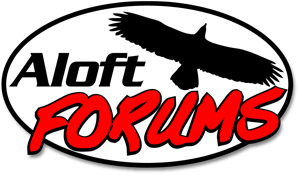Konrad
Very Strong User
Many of you might not know this, but if you purchase an aircraft with your sales order many of the electrical components in that order will have a 10% discount from Aloft Hobbies.
This doesn't need to be a high dollar aircraft!
To that end these little Precision Products (TopModel) gliders can pay for themselves!
It is not unusual for me to spend $500 on servos, motors and ESC and other radio support equipment every time I step into Aloft's warehouse. So I've effectively gotten these gliders for free!
This little minus Thermic caught my eye, and for $50 looked to be a fun novelty built. I chose the minus Thermic over the minus Acro as I want a little more wing area for those light lift days.
https://alofthobbies.com/top-model-minus-thermic.html
What is real nice about the kit is that the plans show and give instruction for both models. This can also be a problem in that you really need to study the plans (TopModels has tried to highlight what is different between the models).
In this thread I will document my build of the minus Thermic. This should not be thought of as a kit review! What I really like about kits is that it is often much easier to customize the model to your own need than starting out with an ARF.
Looking over the model I really like the laser cutting. The plans and instruction are written in both French and English which make it easer for me to follow than some of the same types of models we can get from Asia.
What I really like about the minus Acro is that the airfoil is symmetrical and the ailerons are a bit wider than what we find on the minus Thermic.
What I don't like about both models is that the V Tail angle is the ubiquitous Beech 110°. And that the V tail cord and area look to be a bit small.
I'll look into changing the V tail angle and chord based on my limited understanding of how to size and set up a V tail. It is my understanding that the V tail angle is highly dependent on the aspect ratio of the wing and the fuselage moment arm. The chord is critical with these super small models as the Reynolds number are really working against us.
On my minus Thermic I hope to widen the aileron chord for more low speed roll authority. I'm also looking into adding a second aileron servo to allow camber changing and spoileron control. I think I can make all these modification with the wood supplied in the kit.
While the kit is called a Minus Thermic I hope to have a light lift slope ship when I'm done.
This doesn't need to be a high dollar aircraft!
To that end these little Precision Products (TopModel) gliders can pay for themselves!
It is not unusual for me to spend $500 on servos, motors and ESC and other radio support equipment every time I step into Aloft's warehouse. So I've effectively gotten these gliders for free!
This little minus Thermic caught my eye, and for $50 looked to be a fun novelty built. I chose the minus Thermic over the minus Acro as I want a little more wing area for those light lift days.
https://alofthobbies.com/top-model-minus-thermic.html
What is real nice about the kit is that the plans show and give instruction for both models. This can also be a problem in that you really need to study the plans (TopModels has tried to highlight what is different between the models).
In this thread I will document my build of the minus Thermic. This should not be thought of as a kit review! What I really like about kits is that it is often much easier to customize the model to your own need than starting out with an ARF.
Looking over the model I really like the laser cutting. The plans and instruction are written in both French and English which make it easer for me to follow than some of the same types of models we can get from Asia.
What I really like about the minus Acro is that the airfoil is symmetrical and the ailerons are a bit wider than what we find on the minus Thermic.
What I don't like about both models is that the V Tail angle is the ubiquitous Beech 110°. And that the V tail cord and area look to be a bit small.
I'll look into changing the V tail angle and chord based on my limited understanding of how to size and set up a V tail. It is my understanding that the V tail angle is highly dependent on the aspect ratio of the wing and the fuselage moment arm. The chord is critical with these super small models as the Reynolds number are really working against us.
On my minus Thermic I hope to widen the aileron chord for more low speed roll authority. I'm also looking into adding a second aileron servo to allow camber changing and spoileron control. I think I can make all these modification with the wood supplied in the kit.
While the kit is called a Minus Thermic I hope to have a light lift slope ship when I'm done.
Last edited:

